Ramna Park (Bengali: রমনা পার্ক, romanized: Rômnā Pārk, or Bengali: রমনা উদ্যান, romanized: Rômnā Udyān) is a significant urban green space renowned for its historical significance and recreational amenities, situated at the centre of Dhaka, Bangladesh. Described the "lungs of Dhaka City,"[1] the 68.50-acre (277,200 m2) park was built during the British colonial era with a lake at its core, undergoing several transformations over the years and evolving into a popular public space. Additionally, Ramna Park hosts cultural events and festivals, notably, the yearly Bengali New Year celebrations, further enriching its role as a communal space for relaxation and social gatherings.
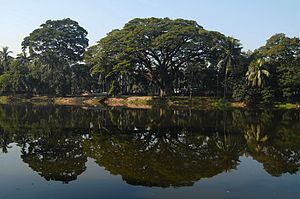
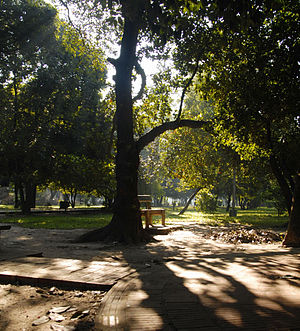
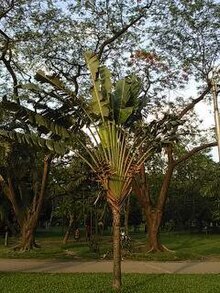
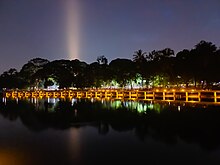
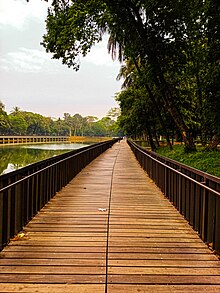
History
editBackground
editBefore the early 20th century, the present-day site of Ramna Park comprised a vast empty expanse known as Ramna Plains. Situated in its midst was a sizable lake, while nearby stood a racecourse in Suhrawardy Udyan, both built by Dhaka's magistrate Charles Dawes.[2]
Construction and inauguration
editIn 1908, R.L. Proudlock from Kew Botanical Gardens in London was tasked with landscaping and enhancing the beauty of Ramna. Today's renowned Ramna Park owes its development to his planning. The park's design included lofty trees, vibrant flowering plants, gardens, and water features. The construction work of the main park spanned 20 years. Initially, a zoo operated in this vicinity, established by the Nawabs of Bengal, before being relocated to Mirpur.
Ramna Park was formally inaugurated in 1949, covering an area of 88.5 acres (358,000 m2). The expansive open spaces served as venues for fairs and exhibitions. Notably, in 1960, Queen Elizabeth II received a warm civic reception at Ramna Park during her visit to Dhaka.[2]
Developments
editThe current layout of Ramna Park was conceptualised in 1952 by the Public Works Department of Bangladesh (formerly known as the C&B Department). Enhancements to the park included deepening and extending the lake, constructing walkways and garden paths in stages, regrading and replanting sections, and implementing irrigation systems for the diverse range of tree saplings. To facilitate deep root growth, tree wells with deep vertical tubes or watering pipes were installed. Additionally, a bud-shaped water tower was erected on the park's northern side to supply water to these facilities.[3]
In 2020, Ramna Park was closed to the public as a precautionary measure to mitigate the spread of the Coronavirus pandemic. During this period of closure, a beautification drive were undertaken by the Public Works Department at a cost of ৳460 million (US$3.8 million), which involved the construction of a new wooden deck around the re-excavated lake, new lighting systems, and rebuilding of paths covered with red ceramic bricks and bituminous carpet. Additionally, a new cafe has been built and a corner of the park has been dedicated to children's play areas, while new flowers have been planted as part of the renovation work.[4][5] The park was reopened towards the end of 2022.[6]
Incidents
editOn 14 April 2001, during the Pohela Boishakh celebrations of the Bangla New Year, two bombs exploded at Ramna Park, resulting in the deaths of 10 individuals and injuries to several others. Subsequently, members of the Islamist group Harkat-ul-Jihad al-Islami were convicted in connection with the incident.[7]
Geography
editRamna Park is situated at the centre of Dhaka[8] and presently covers an area of 68.50 acres (277,200 m2), of which the lake covers 8.76 acres (35,500 m2). Walkways inside park have been widened and five new gates built for entry from different sides.[9]
Flora
editRamna Park contains a total of 71 species of flowering plants, 36 species of fruit trees, 33 species of medicinal plants, and 41 species of forestry plants, along with an additional 11 species.[2]
Ornamental flower plant species include J. sambac (Beli), B. acutangula (Hijol), C. fistula (Sonalu), C. pulcherrima (Radhachura), M. elengi (Bokul), M. paniculata (Kamini), P. (Kathgolap), N. arbor-tristis (Sheuli), B. ceiba (Shimul), N. cadamba (Kodom), L. speciosa (Jarul), N. arbor-tristis (Shephaly), B. monosperma (Polash), A. moniliformis (Akashmoni), M. champaca (Chapa), C. bakeriana (GolapiSonalu), C. ternatea (Aparajita), T. divaricata (Togor), I. coccinea (Rangan), P. pterocarpum (Konokchura), M. indica (Mohua), A. pavonina (Raktochandan), R. damascena (Golap), B. acuminata (Sada Kanchan), T. patula (Gada), B. glabra (Bagan Bilash), M. diplotricha (Lazzabati), A. hexapetalus (Kathalichapa), C. cristata (Morogphul), G. globosa (Botamphul), C. reflexa (Sarnalata), C. roxburghii (Lal-golapiSonalu), C. nocturnum (Hasnahena), B. purpurea (Raktakanchan), H. mutabilis (Jaba), C. variegatum (Patabahar), I. quamoclit (Gateful), C. morifolium (Chandramallika), D. metel (Dutra), G. tiliifolia (Rakta Kusum), J. auriculatum (Jui), A. dichotoma (Malatilata), J. grandiflorum (Chameli), B. variegata (Lalkanchan), J. sambac (Beli), A. leptopus (Anantalata), K. rotunda (Bhuichapa), H. coronarium (Dolon Chapa), M. indica (Mohua), M. jalapa (Sandhyamalati), P. indica (Kathchapa), M. champaca (Sharna Chapa), N. oleander (RaktaKarobi), M. grandiflora (Uday Champa), P. foetidus (Keya), B. acuminata (Sadakanchan), D. regia (Krishnochura), and M. pterocarpa (DuliChampa).[9]
Bengali New Year celebrations
editThe yearly celebration of Bengali New Year, known as Pohela Boishakh, kicks off at dawn with arrangements made by the cultural organisation Chhayanaut, marking the beginning of the year at the historic Ramna Batamul banyan tree located in Ramna Park, which serves as the stage for a cultural extravaganza on Pohela Boishakh. During this festivity, women adorn themselves in white sarees with red borders, while men wear traditional Panjabi attire.[10][11]
References
edit- ^ Chandan, Md Shahnawaz Khan (5 August 2016). "The City's Oasis". The Daily Star. Star Weekend. Retrieved 13 May 2024.
- ^ a b c Rahman, Mohammad Motiar; Mostafiz, Shanu; Begum, Aysha; Ahmed, Sharifuddin (June 2012). Ahmed, Sharifuddin; Hasan, Delwar; Majlish, Najma Khan; Rabbani, AKM Golam (eds.). Encyclopedia of Dhaka ঢাকা কোষ (in Bengali). Dhaka: Asiatic Society of Bangladesh. pp. 345–352. ISBN 978-984-512-019-7.
- ^ "The City We Built". The Asian Age. 10 September 2016. Retrieved 13 May 2024.
- ^ Sarker, Rasel (19 May 2023). "New-look Ramna Park comes alive with birds, squirrels and joggers". bdnews24.com. Retrieved 13 May 2024.
- ^ "New-look Ramna Park". bdnews24.com. 6 February 2022. Retrieved 13 May 2024.
- ^ "Adults take over kids' play areas at Ramna Park". The Daily Observer. 3 February 2024. Retrieved 13 May 2024.
- ^ "2001 Ramna Batamul attack: A timeline". The Daily Star. 14 April 2024. Retrieved 13 May 2024.
- ^ Chandan, Md Shahnawaz Khan (5 August 2016). "Dhaka's Green Heart". The Daily Star. Retrieved 13 May 2024.
- ^ a b Pasha, A.B.M. Kamal; Chowdhury, Azharul Haque; Hussain, Asif; Rahman, Mahmudur; Fuente, Jayson A. Dela; Mozumder, Sagar (10 November 2021). "Identification of the ecosystem services and plant diversity in Ramna Park Dhaka". Science Progress and Research. 1 (4): 345–356. doi:10.52152/spr/2021.141. ISSN 2635-0955.
- ^ "Nation celebrates Pahela Baishakh". New Age. 14 April 2019. Retrieved 13 May 2024.
- ^ Tinni, Taslima Rawshan (14 January 2007). "Ramna Park: A Magnificent Garden in the Heart of Dhaka". Star Campus. Vol. 2, no. 1. Retrieved 13 May 2024.